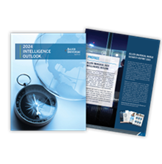
In an era marked by unprecedented global connectivity, corporate security professionals are tasked with safeguarding their organizations amidst a sea of evolving challenges. As 2024 matures, the world remains in a state of flux, shaped by dynamic geopolitical forces, societal shifts and emerging threats. It is within this volatile landscape that security experts must navigate, adapt and innovate to protect their most valuable assets – both human and property.
In the second installment of our series, "Securing Your Assets in a Volatile World," we delve deep into the heart of the matter, exploring two critical dimensions: "Security and Civil Unrest" and "Terrorism and Crime." Drawing insights from the recently released Allied Universal® 2024 Intelligence Outlook, we review the global trends that underpin these security challenges, dissecting the intricate web of risks that may emerge from these tumultuous forces.
This article is not merely about identifying risks; it's about empowering you, the corporate security professional, with the knowledge and strategies needed to mitigate them effectively. As we proceed, we'll analyze the high-level trends shaping our world, dissect the corporate security risks that may arise, and present practical tactics and solutions to fortify your organization against an ever-changing global landscape.
High Level Trends
As detailed in the Allied Universal 2024 Intelligence Outlook, crime and unrest appear to be on the upswing globally. Demonstrations and protests related to climate change, geopolitical conflict, dissatisfaction with governments, and labor rights and austerity measures are a common trend globally, with widespread regional activism. These protests often involve nonviolent actions but may escalate, leading to disruption and property damage.
In addition to social unrest, trends around crime and terrorism are also burgeoning. Organized crime and illicit trafficking, including drug trafficking, human trafficking and smuggling, are increasing concerns globally. Organized retail crime and maritime piracy are also rising in some areas of the globe, along with cybercrime threats. Extremist and online radicalization, often driven by ideological, racial or religious motivations, are a shared concern in different parts of the world. Global shifts in population are driving risk with irregular migration, border security and related challenges as common trends impacting both the origin and targeted destination countries. These issues can have security implications and disrupt economic activities.
Corporate Security Risks to Be Aware Of:
Upward trends of crime and civil unrest globally can significantly impact business assets, operations and employees. Some of the potential risks that corporate security professionals must be vigilant about include:
- Physical Harm to People: Terrorism and civil unrest present significant risks of physical harm to employees, both within a corporation and within its supply chain partners. Human trafficking, assaults, ransom holds and crew member abductions from shipping vessels are often used by criminal organizations to meet demands for cheap labor, goods theft and power struggles between organized crime groups. Local security tensions may impact the safety of employees working in border regions, necessitating additional security measures. With a predicted increase in inflation rates spiking the cost of goods and services, threats of attacks on personnel in unstable environments are likely to continue.
- Property Damage and Theft: Protests and civil unrest can lead to property damage, theft, and destruction of corporate assets, resulting in financial losses. Common global points of contention include climate change, labor and human rights, global conflict, and government policies. Demonstrations that escalate to violence and property destruction can lead to severe revenue losses for businesses. Increased retail theft and shoplifting pose additional financial risks to businesses through asset loss, potentially leading to reduced profitability and manufacturing ability.
- Harm to Brand Reputation: Environmental protests and labor strikes are often directed toward individual brands or local policies. Boycotts of products and brands are common and can lead to business reputations suffering, resulting in reduced sales and profits.
- Operations Disruptions: Protests, strikes and supply chain vulnerabilities can disrupt day-to-day business operations, negatively affecting productivity and revenue. Labor strikes can impact company productivity, which may lead to staffing shortages and even revenue losses. Supply chain disruptions, including theft of goods, production shortages and abductions can lead to large-scale financial losses for companies and decreased product output.
- Supply Chain Disruptions: Companies may experience delays in the delivery of essential goods and services due to supply chain vulnerabilities. Goods delays and product theft can create higher financial burdens in the production process for businesses that may overproduce to compensate for losses. Many businesses may have to seek secondary production sources, which may lead to higher production costs.
Potential Risk Mitigation Strategies:
The risks posed to businesses by increasing global crime, terror and civil unrest are severe, but there are steps that companies can take to mitigate the impact of these corporate security risks. Consider the following strategies:
- Proactive Monitoring: Continuously monitor global trends, protests and security threats through intelligence sources to stay ahead of potential issues.
- Physical Security: Enhance physical security through well-trained on-site security/patrol officers, state-of-the-art surveillance systems (CCTV, motion sensors), strict access control (biometric scans, electronic locks) and well-practiced emergency response plans tailored to different scenarios, fostering employee awareness and clear communication channels for coordinated responses.
- Employee Training: Train employees comprehensively with security awareness programs, enabling them to recognize threats, report incidents and follow security protocols. Conduct routine scenario-based exercises encompassing diverse threats like bomb threats, cyberattacks and physical breaches to ensure preparedness for real-world security challenges.
- Collaboration: Foster collaboration with local law enforcement through community engagement and information sharing, facilitating proactive security measures with shared threat intelligence. Additionally, collaborate with government agencies responsible for security and emergency management, engaging in public-private partnerships to bolster overall security and resilience efforts.
- Contingency Plans: Develop comprehensive contingency plans encompassing various scenarios like natural disasters, political instability, supply chain disruptions and cybersecurity incidents. Strategically allocate critical resources, personnel and equipment for effective plan execution, minimizing downtime and preserving essential operations. By incorporating these detailed measures into your security strategy, you can proactively address security risks, bolster resilience and enhance your organization's ability to navigate the challenges posed by civil unrest, terrorism and crime in the ever-evolving global landscape.
The Allied Universal 2024 Intelligence Outlook shows that in the coming year, we will all be navigating new terrain shaped by ever-shifting global trends and security risks. By equipping security teams with insights, proactively identifying potential threats, and implementing resilient mitigation strategies, organizations can shield their invaluable human and property assets, ensuring uninterrupted business operations even in the face of uncertainty. As we move forward, adaptability, meticulous preparation and collaborative efforts will serve as the linchpins to conquering the challenges that await on the horizon.
The insights we've uncovered today are just a fraction of the comprehensive global intelligence picture. This article marks the second installment in our series, where we explore the Allied Universal Annual Intelligence Outlook in-depth. In our upcoming article, we will delve into the realm of cybersecurity, shedding light on the trends and outlook that may influence your security program in the forthcoming year.
Download the Allied Universal® 2024 Intelligence Outlook here.
























